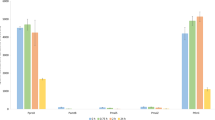Abstract
The T7 promoter is commonly used in E. coli expression studies but has several disadvantages due to induction with isopropylthio-β-D-galactoside (IPTG) including the prohibitive cost of IPTG, reduction in cell growth, and the poisonous nature of IPTG prohibiting its use in pharmaceutical products. The chloroplast psbA promoter produces an 18.5 fold increase in expression in E. coli compared to the T7 promoter. Also, the psbA promoter does not have the disadvantages of induction with IPTG.
Similar content being viewed by others
References
Boyer, S.K. and Mullet, J.E. (1986). Plant Mol. Biol. 6, 229–243.
Cornelissen, M. and Vandewiele, M. (1989). Nucleic Acids Res. 17, 19–29.
Daniell, H. (1993). Methods Enzymol. 217, 536–556.
Daniell, H. and McFadden, B.A. (1987). Proc. Natl. Acad. Sci. USA 84, 6349–6353.
Daniell, H., Guda, C., McPherson, D., Zhang, X. and Urry, D. (1996). Methods Mol. Biol. 63, 359–371.
Daniell, H., PoroboDessai, A., Prakash, C.S. and Moar, W.J. (1994). In: Biochemical and Cellular Mechanisms of Stress Tolerance in Plants, J.H. Cherry, ed. Vol. H 86, pp. 589–604, NATO ASI Series in Cell Biology, Springer-Verlag, Berlin Heidelberg.
Guda, C., Zhang, X., McPherson, D.T., Xu, J., Cherry, J.H., Urry, D.W. and Daniell, H. (1995). Biotech. Lett. 17, 745–750.
Laemmli, U.K. (1970). Nature 227, 680–685.
Lee, C., Levin, A. and Branton, D. (1987). Anal. Biochem. 166, 308–312.
Lewin, B. (1990). Genes IV. Oxford University Press, New York, pp. 416–435.
Masui, Y., Mizuno, T. and Inouye, M. (1984). Bio/Technology 2, 81–85.
McPherson, D.T., Xu, J. and Urry, D.W. (1996). Protein Expression and Purification 7, 51–57.
Studier, F.W. and Moffat, B.A. (1986). J. Mol. Biol. 189, 113–130.
Tartof, K.D. and Hobbs, C.A. (1987). Bethesda Res. Lab. Focus 9, 12.
Urry, D.W. (1995). Scientific American, 272, 64–69.
Zhang, X., Guda, C., Datta, R., Dute, R., Urry, D.W. and Daniell, H. (1995). Biotechnology Letters 17, 1279–1284.
Author information
Authors and Affiliations
Rights and permissions
About this article
Cite this article
Brixey, P., Guda, C. & Daniell, H. The chloroplast psbA promoter is more efficient in Escherichia coli than the T7 promoter for hyperexpression of a foreign protein. Biotechnology Letters 19, 395–400 (1997). https://doi.org/10.1023/A:1018371405675
Issue Date:
DOI: https://doi.org/10.1023/A:1018371405675




